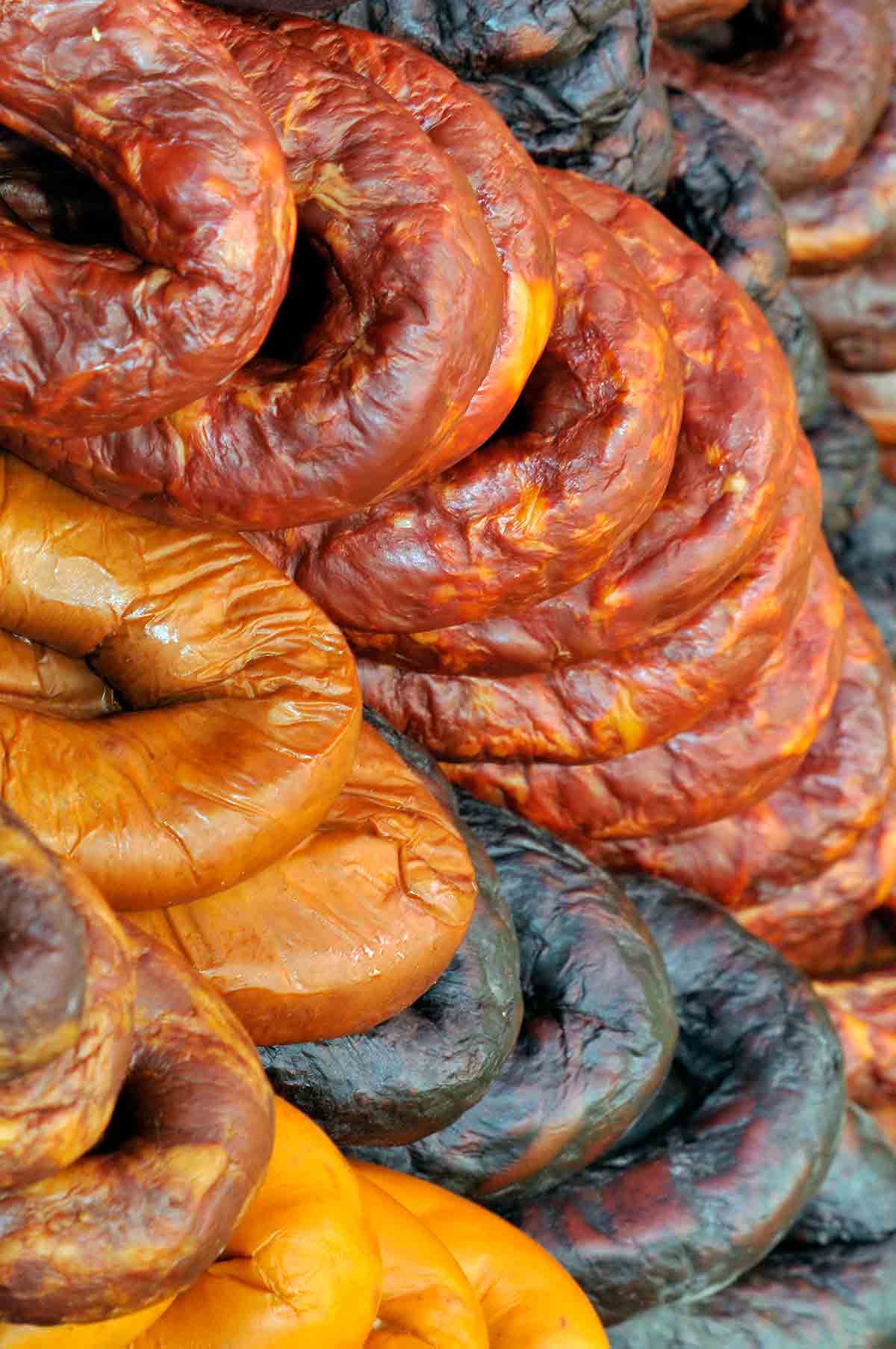
If the symbol of working-class prosperity in the United States was once, as Herbert Hoover said, a chicken in every pot, then, unquestionably, in Portugal it’s a dry-cured smoked sausage in every pan.
So ubiquitous are sausages, as well as hams, that until very recently nearly every country household made its own. My family still does. My Uncle Joe even built a smoker the size of a minivan in the middle of Somerville, Massachusetts, so my Aunts Irina, Exaltina, and Lourdes can gather several times a year to make our family’s truly incomparable sausages.
How to buy Portuguese sausages
If you have the chance to buy Portuguese sausages at the market, make sure they’re firm, not soft (with the exceptions of those noted below). Spongy links mean a lot of fillers, bloated ones mean waterlogged. True artisanal sausages are bumpy with dry skin—sometimes with a harmless white bloom on it—and a deep smoky aroma. If in doubt, ask the butcher.

Chouriço (show-rhee-soo)

It’s my experience that chouriço is the favored link in Portugal. Made from chunks of pork loin with a good amount of added fat—the proportions are always the secret of the maker—plus loads of paprika, garlic, red or white wine, and hot piri-piri sauce, chouriço is first air-dried and then heavily smoked.
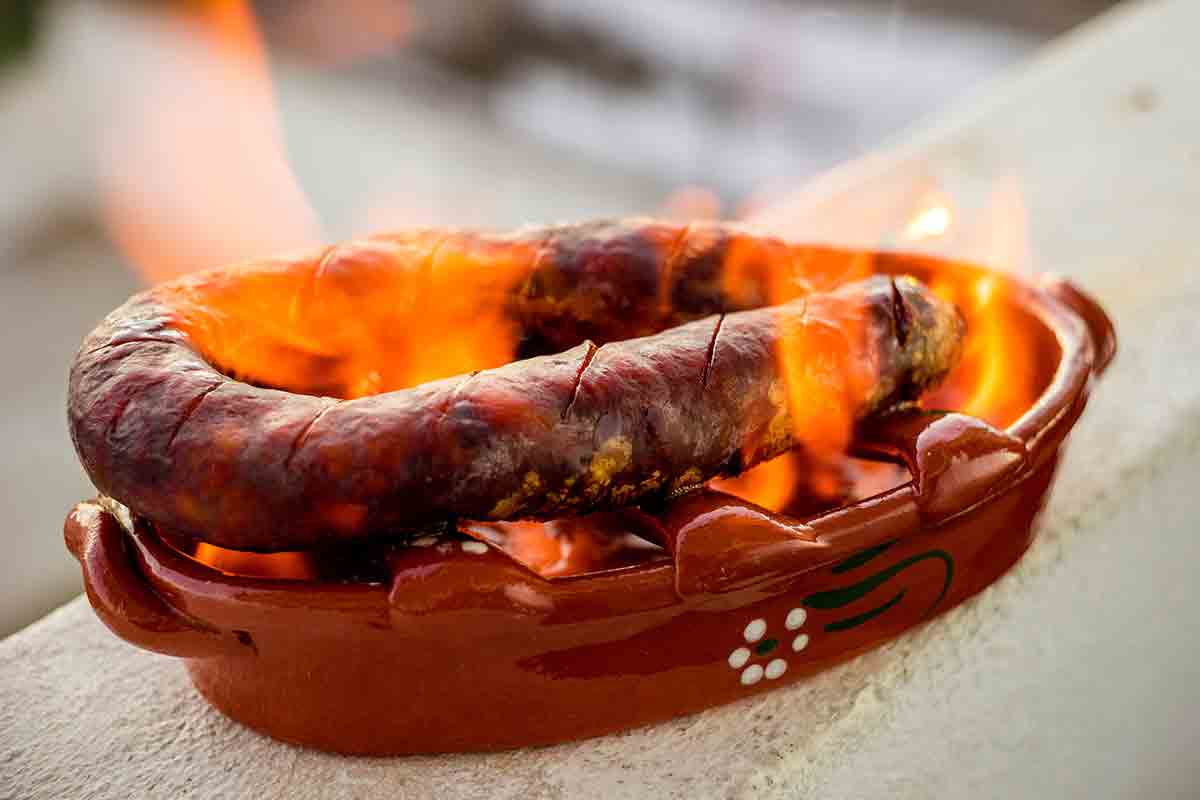
Cooks serve them boiled, grilled, fried, or roasted. One of the showier presentations is firemen’s sausage, where a link of sausage is doused with aguardente, a powerful distilled spirit, and set ablaze. Amid a great whoosh of flame, and shrieks from the table, the sausage’s skin chars and blisters and the meat takes on a sweetness when dipped in the liquor.
Homestyle chouriço (.80 pound), $7.99 from Portugalia Marketplace
Linguiça (leen-gwee-suh)
Some Portuguese may have conniptions when they read this, but nonetheless, it’s true: there’s virtually no difference between chouriço and linguiça. They’re made from the same basic ingredients in the same exact manner. Still, some Portuguese insist that linguiça is spicier, yet I’ve had some chouriço so hot it blisters your lips. Others maintain that linguiça is more finely ground or leaner than chouriço. Not necessarily true.
After a decade of asking questions on two continents, I’ve come to the conclusion that any slight difference tends to be the result of the producer as opposed to nationally accepted categorization.
The only consistent distinction is that linguiça is smaller in diameter because it’s made from the small intestines of a pig, while chouriço is made from the large. (Some producers use beef casings for chouriço, hence the larger size.) Oh, one other misconception: linguiça is not made from tongue, even though lingua is the Portuguese word for tongue.
Linguiça does a star turn in Porto’s arguably most famous sandwich, the Francesinha. This “Little Frenchie,” boasts piles of sliced ham, linguiça, and roasted beef all smothered in melted cheese and naped with a spicy tomato-beer sauce. And it ain’t a Francesinha without french fries on the side.
For both chouriço and linguiça, you can substitute Spanish chorizo, but make sure it’s the dry-cured version; Spain also makes a raw product. Be forewarned, though: Spanish links can be much fattier than chouriço or linguiça, so drain or skim the fat during cooking. Regarding the skin, you can leave it on or remove it—your choice.
Linguiça (1 pound), $5.99 from Portugalia Marketplace
Morcela (mord-sal-ah)
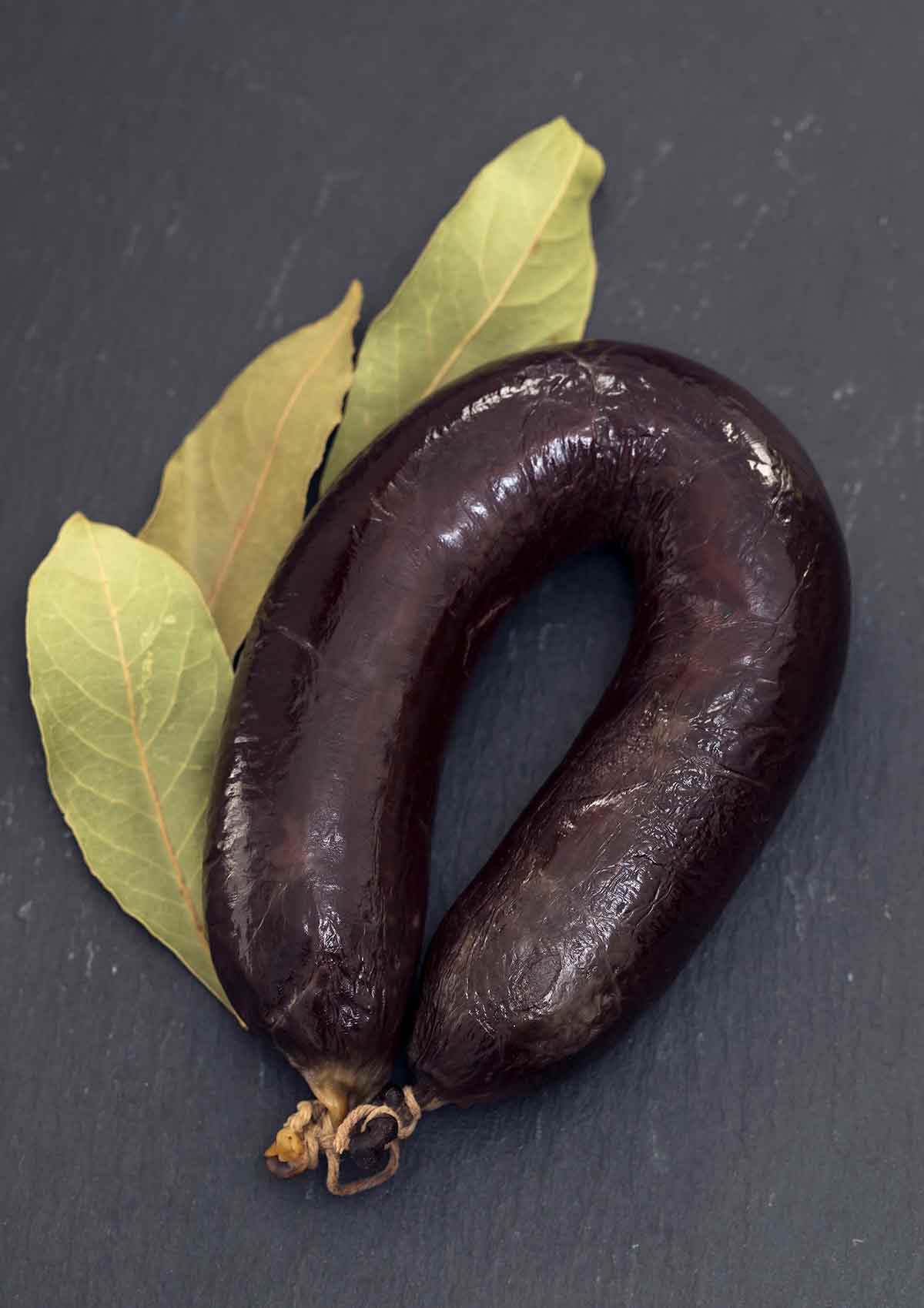
Yes, morcela, also known as blood sausage or blood pudding, is indeed made with…blood. Typically pig. Now, before you start having flashbacks of the movie “Carrie,” people really do love it–my family is nuts for it. (I happily admit, I’m one of the only holdouts.)
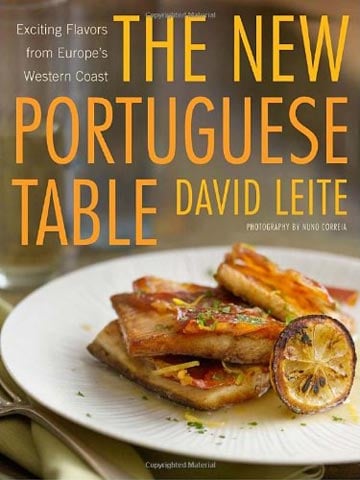
When my father was growing up on the island of São Miguel in the Azores, my grandfather raised a pig each year. The slaughter, or matança, which took place in early December, provided food for all seven members of the Leite household for the entire year. Nothing was wasted, and that included the blood.
The morcela Azoreans are most familiar with contains no meat–just pork fat, blood, onions, garlic, and spices and is, understandably, quite rich.
But you can find morcela all over the country and in endless variations. In some regions, sausage makers make it with cloves, cumin, nutmeg, and/or pepper. In other areas, you can find morcela de arroz, blood sausage studded with cooked rice. Throughout the Alentejo, a region in the south of Portugal, producers prefer to cure their morcela by boiling rather than smoking. And if that weren’t enough, certain regions produce morcela with pork meat marinated in blood.
Morcela makes an appearance in feijoada (a stew of pork, sausages, and beans) and in cozido (a kind of a Portuguese pot au feu–a boiled dinner of meat, sausages, and vegetables). Cooks also prepare it fried, grilled, and sauteed and serve it with fries, rice, and eggs. In the Azores, morcela often shares a plate with fresh pineapple–one of São Miguel’s most famous crops.
Morcela (.75 pound), $5.99 from Portugalia Marketplace
Alheira (al-yay-dah)
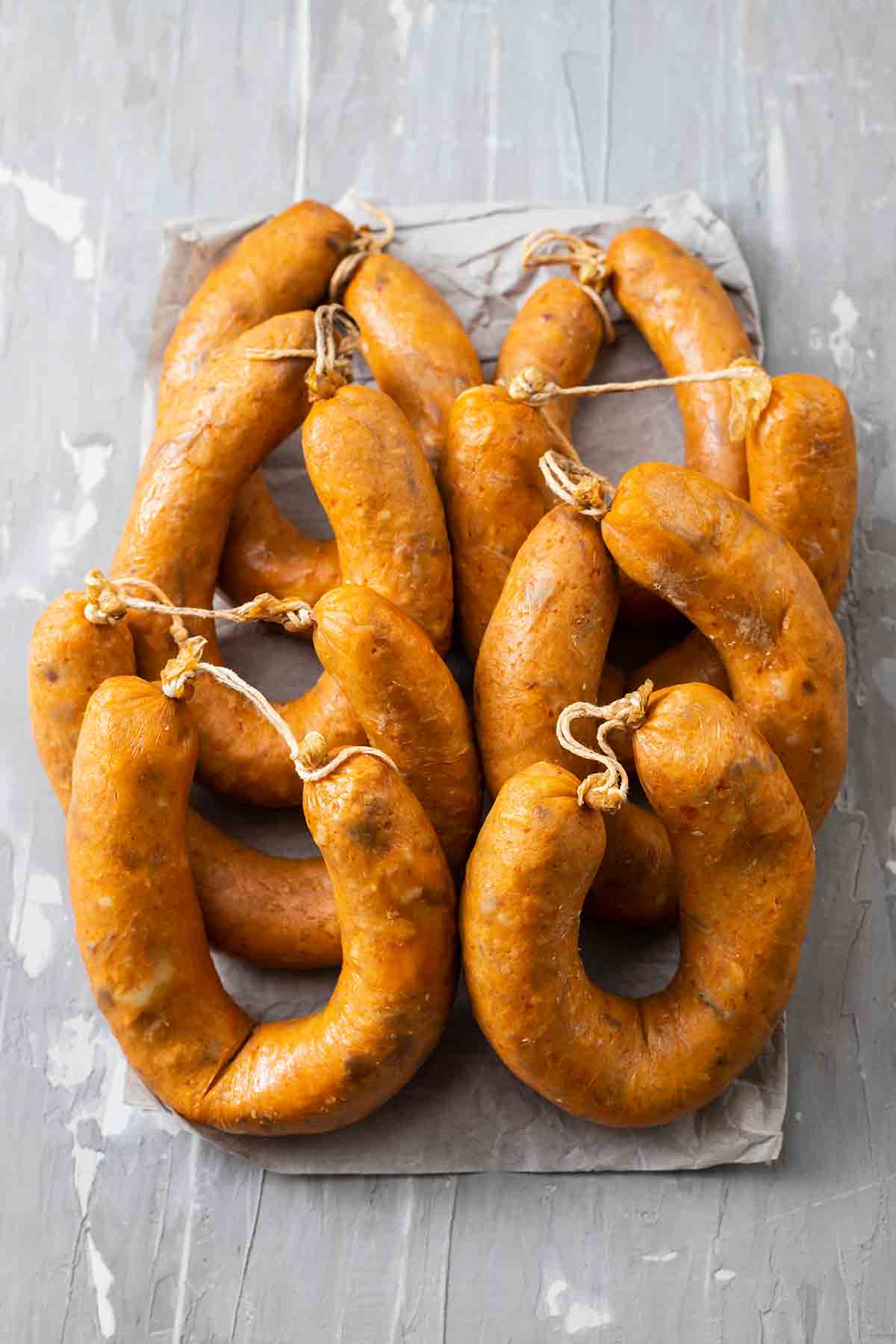
Alheira is rare among the canon of Portuguese sausages. It’s one of only two created for political reasons. In 1497, King Manuel I of Portugal decreed all Jews in the country had to convert to Catholicism or face expulsion–to distant and unhospitable countries including former Portuguese colonies on the western coast of Africa. Many of the Jews who remained and converted, aptly called conversos, faced a dilemma. They wanted to secretly maintain their Judaic traditions and practices while outwardly looking like good Christian soldiers. One of the hardest traditions to keep was eschewing pork in a country that unapologetically worships the pig.
Every home had a small fumeiro, or smokehouse, and eyebrows would raise if no pork sausages were smoking. To escape notice and keep kosher, these conversos cleverly seasoned other non-forbidden meats, such as game and poultry, and bread with the same wine and spice combinations as chouriço and linguiça and then smoked them. Hostile neighbors, suspicious priests, and the authorities were none the wiser.
Nowadays, alheira is no longer kosher as it’s made from various combinations of pork, duck, chicken, quail, hare, and rabbit. Typically served fried or grilled with blistered, charred skin, alheira is beloved all over the country.
Two of Portugal’s finest alheiras enjoy protected status, Indicação Geográfica Protegida (IGP), meaning their quality and reputation are inextricably linked to the geographical area where they’re produced: Alheira de Vinhais in the Bragança district, and Alheira de Barroso-Montalegre, in the Trás os Montes region.
Alheira (~ 1 pound), $7.99 from Portugalia Marketplace
Farinheira (fa-reen-yay-dah)
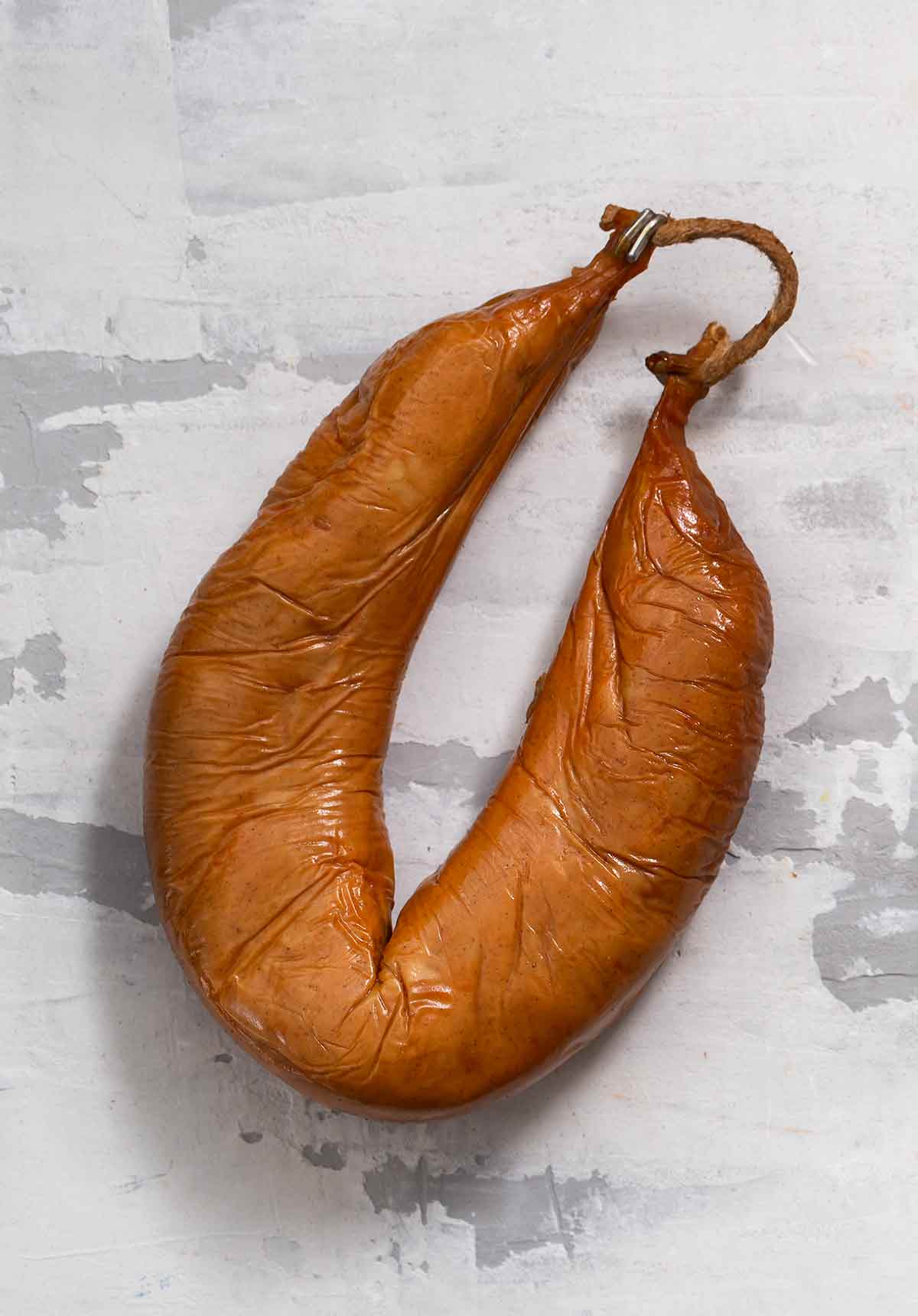
Farinheira is the other Portuguese sausage born out of political necessity. Like with alheira, Jews who fled persecution in Spain created farinheira as a way to avoid detection in Northern Portugal.
Its name derives from the Portuguese word “farinha,” which translates to “flour,” its main ingredient. Originally, bereft of any porky goodness, the filling nowadays consists of wheat flour mixed with plenty of pork fat, white wine, garlic, and paprika. Once stuffed into the casings, the whole thing is smoked. Without the meatiness of chouriço or linguiça, it has a sweeter, milder flavor.
Due to the flour, farinheira is quite soft, so it’s never sliced and cooked like its charcuterie cousins. Cooks usually add whole links to brothy dishes such as feijoada or cozido. They also remove it from its casings, break it up in a skillet, and sauté it. Then they spread it on toasted bread as a petisco, or small bite. One very popular dish is ovos mexidos com farinheira–eggs scrambled with crumbled farinheira.
Farinheira (~0.66 pound), $6.99 from Portugalia Marketplace
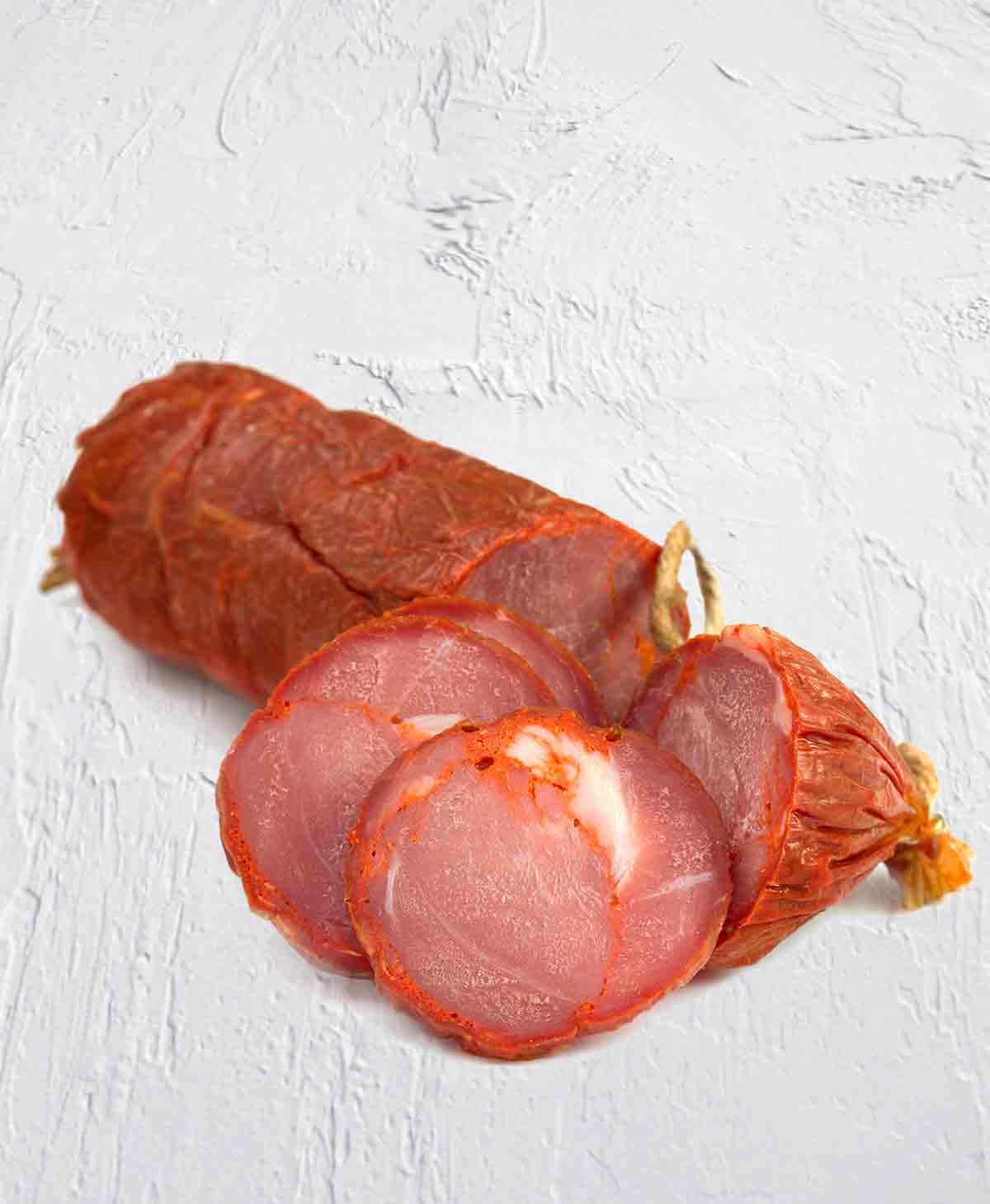
Salpicão and paio
Salpicão and paio are kissing cousins. Unlike most other smoked Portuguese sausages that are made from chunks of fatty pork shoulder, these two ready-to-eat links are made from the loin. (Think Canadian bacon but with lots of sass.)
Besides pork loin, salpicão also contains wine, bay leaf, garlic, paprika, and salt. Paio, on the other hand, contains vinegar or wine, garlic, salt, and paprika or massa de pimentão, a salty paste of sweet red peppers. The major difference between them is paio tends to be larger in diameter.
In the Alentejo, you’ll also find paio branco (white paio). It’s made from Alentejan pigs–they’re the lucky ones who get to sup on cork oak acorns, which give the meat its distinctive, slightly sweet flavor. These sausages don’t contain paprika or massa de pimentão, so it’s lighter in color, hence the name.
Salpicão (~1 pound), $8.99 from Portugalia Marketplace
Presunto (preh-zoon-too)
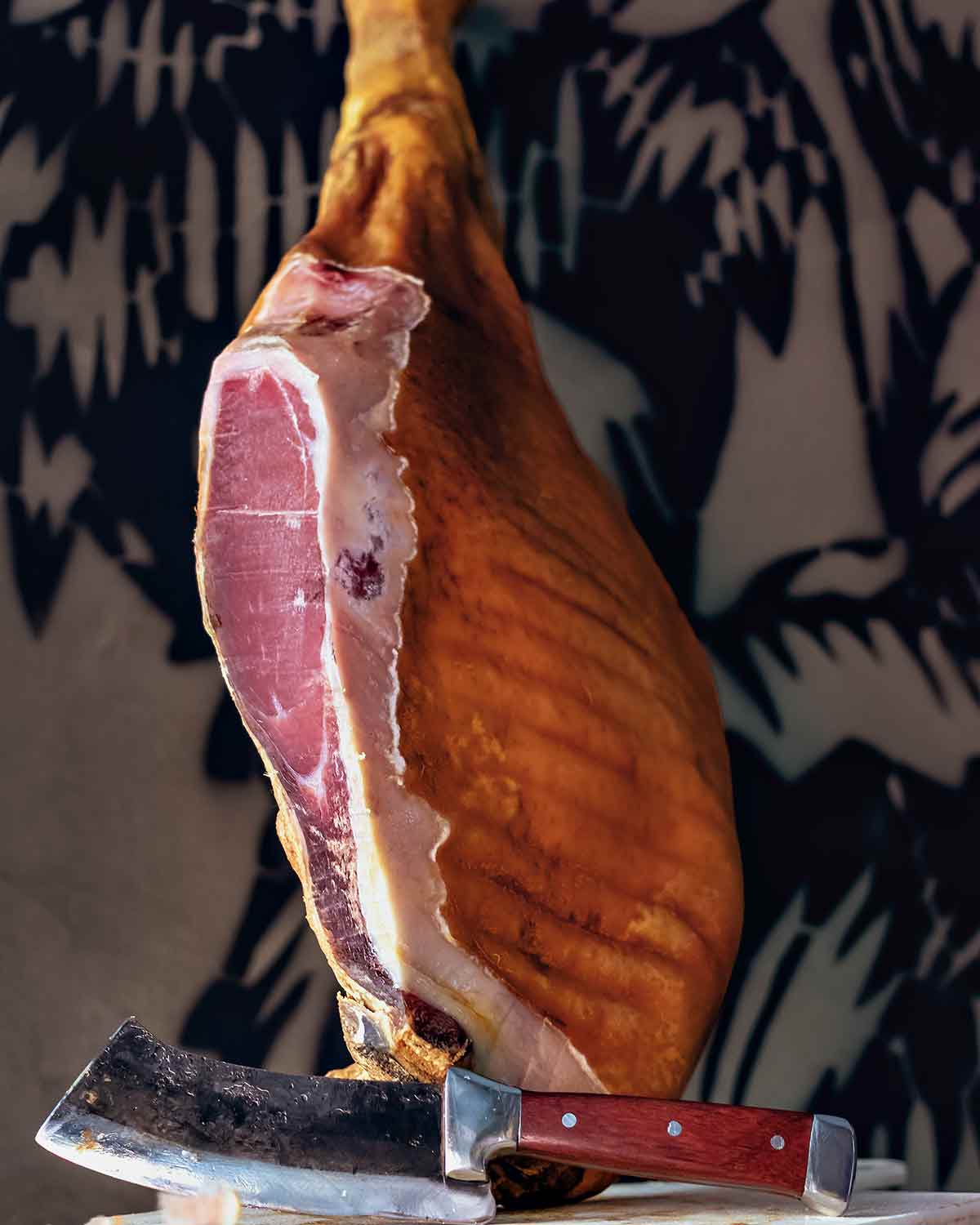
While not sausage, this dry-cured ham of Portugal deserves a spot here, as it has few rivals. Its supremacy comes from allowing the pigs to gorge themselves for up to sixty days on cork oak acorns (same as for paio branco above) before meeting their fate, as well as from the laborious process of quick-salting, rinsing, long-term salting, and natural air drying. This leaves the sublimely silky meat a deep red purple with superb marbling, ringed by a layer of opalescent ivory fat.
The country’s two finest areas for presunto production are the towns of Chaves and Lamego, in the Trás-os-Montes region in the north, which rubs its hams with a coating of sweet paprika and olive oil before smoking; and the Alentejo, in the south, which prefers to keep its hams uncoated and unsmoked. For the Alentejan presunto, the hoof remains to prove it comes from the famous porco preto, or black pig.
Cooks serve presunto in thin slices on its own, in sandwiches, and alongside fresh fruit. They also use it in cooking to add depth of flavor and a bit of a salty bite. Add it to cheese platters, omelets, or salads, or cut it into small cubes, fry, and sprinkle on baked potatoes.
How long do Portuguese sausages last?
The firmer Portuguese sausages such as chouriço, linguiça, salpicão, and paio can last up to several months if stored in a cool and dry place. But mold can be an issue, so be mindful. Softer sausages, such as morcela, alheira, and farinheira, are best eaten within a week of purchase. All of them can be frozen up to six months.
Don’t toss the oil you cook the sausages in!
When I was a kid, my grandmother, VoVo Costa, and I spoke a combination of cobbled-together Portuguese and English, which I called Portglish. And every once in a while, she’d shout from her kitchen, “Barry, David, Wayne! Quer sheeps?” “Sheeps” was her way of trying to pronounce “chips,” aka fries.
My cousins and I never refused this rare treat. Whenever she’d fry chouriço or linguiça, she’d pour the deeply orange oil into a jar and store it in the fridge. When she’d saved enough, she’d peel some potatoes, cut them into thick wedges, and fry them in the oil. The potatoes would come out orange and tasting of garlic and smoke.
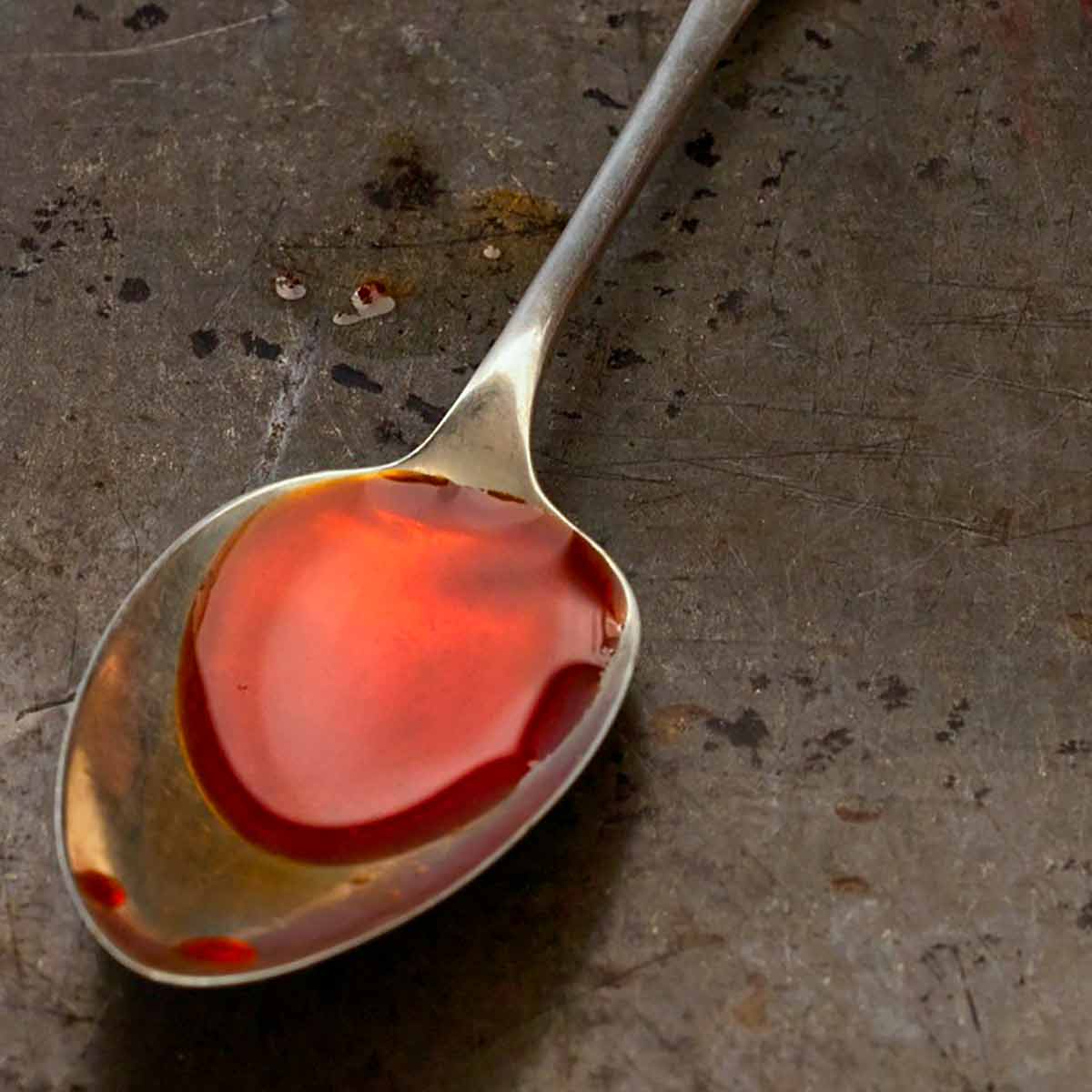
Whenever I fry Portuguese sausage, I think of Vovo, standing at the stove, her thin reedy voice singing along to the soulful fado on the radio. And I think of those fries, and somehow the world rights itself for a moment.










The mention of the blood sausage reminded me of when we butchered pigs. Everything but the squeal was used. If that could have been captured and stuffed into a sausage case, not even the squeal would have been wasted.
My family was of Norwegian and Scotts ancestry and my parents were kids/young adults in the Depression. Nothing was wasted.
Vincent, it’s amazing to me how many people from so many different backgrounds owe a debt to pork.
Boy, did this bring back memories. As a half-Portuguese ten-year-old boy I was invited to go on a trip to the piggery with my 100% Azorean neighbors. I jumped into the pickup truck and watched as my mother and her sister were convulsed in laughter. This city kid soon came face to face with the largest living thing he’d ever seen. Until then my only experience with pigs was of the Warner Bros. type.
I will leave the event at the piggery unspoken, but we accompanied the guest of honor back to the garage and found out what that hook and hoist was for. It seemed like most of the neighborhood turned out, the men with knives and the women with buckets and pails. I can assure you that none of that pig was wasted. To this day linguica remains my favorite treat on the grill.
Bill, I hear you. I understand about the hook and hoist. Although I never was at a matança (slaughter), there is this picture of my family from about 1957.
Thanks so much for the memories the article brought.
I remember my Portuguese grand parents and their friends gathering to butcher a pig in their basement. Rendering the fat and eating the fried skin with fresh bread, packing pork chops and other cuts in crocks, making morecela, stuffing chourico with all her old lady friends and not understanding a word!
Good memories!
scott, you are more than welcome!